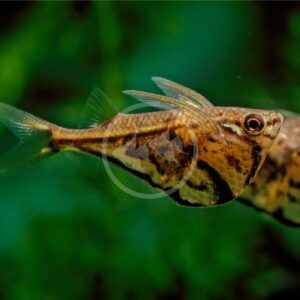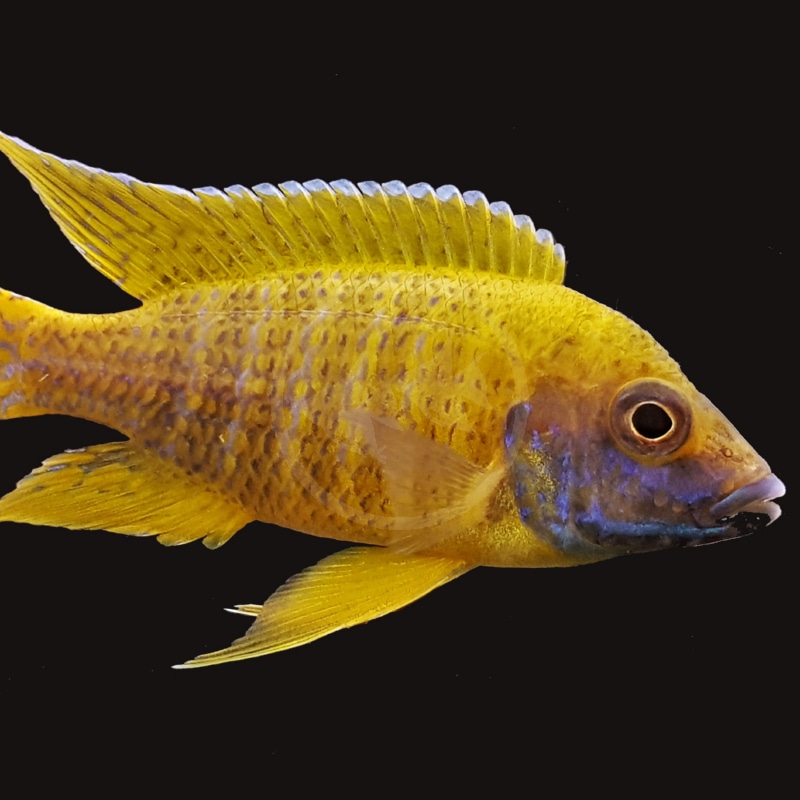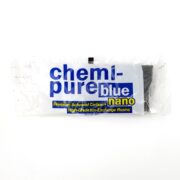
CICHLID – PEACOCK MALERI
Aulonocara stuartgranti “Maleri”
$24.99
There is confusion around the taxonomy of the Maleri Peacock, whether it remains to be an undescribed new taxon underneath a described taxon or if it is in fact a geographic color morph of the Aulonocara stuartgranti, Flavescent Peacock, from the Maleri Islands and Chidunga Rocks of Lake Malawi. Other common names given to this fish include Sunshine Peacock and Yellow Regal Peacock. Aulonocara, or Peacock cichlids, are endemic throughout Lake Malawi in intermediate zones where rocky areas give way to open expanses of sand with scattered rocks. Generally speaking, males will have a vibrant yellow body with little to no blue in the face. The yellow body color of the Maleri peacock is much more pronounced than in the line bred Lemon Jake (A. jacobfreibergi) Peacock. Females, if offered, typically have a gray body with subtle stripes. Maleri peacocks are quite active and would do best in a tank that provides such space for ample exploration and movement. Compatibility is quite variable among these fish, but males tend to be on the more aggressive side and do not coexist well with other Aulonocara males or similarly-colored fish. An adult Maleri peacock can reach a size of approximately 6″.
Care Level: Easy
Temperament: Semi-Aggressive
Live Plant Safe: With Caution
General Description: There is confusion around the taxonomy of the Maleri Peacock, whether it remains to be an undescribed new taxon underneath a currently described taxon or if it is in fact just a geographic color morph of the Aulonocara stuartgranti, Flavescent Peacock, from the Maleri Islands and Chidunga Rocks of Lake Malawi. Other common names given to this fish include Sunshine Peacock and Yellow Regal Peacock. Aulonocara, or Peacock cichlids, are endemic throughout Lake Malawi in intermediate zones where rocky areas give way to open expanses of sand with scattered rocks. Generally speaking, males will have a vibrant yellow body with little to no blue in the face. The yellow body color of the Maleri peacock is much more pronounced than in the line bred Lemon Jake (A. jacobfreibergi) Peacock. Females, if offered, typically have a gray body with subtle stripes. Maleri peacocks are quite active and would do best in a tank that provides such space for ample exploration and movement. Compatability is quite variable among these fish, but males tend to be on the more aggressive side and do not coexist well with other Aulonocara males or similarly-colored fish. An adult Maleri peacock can reach a size of approximately 6″.
Diet Requirements: Maleri peacocks are omnivorous. Various high quality vegetable and protein based flake foods and sinking pellet foods are acceptable. Frozen foods such as spirulina or standard brine shrimp, daphnia, and other mixed freshwater preparations should also be offered. Variety is the spice of life in order to maintain color, immune function and longevity of your fish.
Care Requirements: An established minimum 75 gallon aquarium is ideal for a small Maleri peacock. Biweekly water changes are encouraged to keep water parameters up to standard (Nitrates < 30 ppm). Peacocks do not endure deteriorating water parameters well. The aquarium should be aquascaped with some stacked rocks to create hiding spaces and caves, but for this species, more unobstructed and open swimming space should be provided. The aquarium should also be well oxygenated. A sand-like substrate is needed because Aulonocara spend a considerable amount of time sifting the sand given their benthic nature. Too coarse of substrate can inhibit feeding, damage gills, and even cause internal blockages or damage if ingested. African cichlid specific substrates are great choices because they will buffer the pH and alkalinity to levels characteristic of Lake Malawi. Recommended water conditions, 74-80° F, KH 10-25, pH 7.5-8.5.
Purchase Size: Medium: 2” to 2-1/2”
Note: Your item may not look identical to the image provided due to variation within species. Purchase sizes are approximate.
Dry goods orders are shipped via US Postal Service or UPS to the address provided at checkout based on the selection made in your website shopping cart. Product is carefully packed to help prevent any damage during shipping. Once processed you will receive a shipment notification via email with tracking number, and delivery notification. Please allow 48 hours for processing after your order is placed.
Perishable items (i.e. live plants, refrigerated/frozen foods) are shipped via US Postal Service 2-3 day to the address provided at checkout for a $25.00 flat rate charge. Items are packed with secure packing material and heat, cold, or Cryo packs as needed to maintain safe temperatures during transit. If one or more perishable items are in the shopping cart at checkout the $25.00 perishable shipping charge will automatically appear and need to be selected. Once processed you will receive a shipment notification via email with tracking number. Please allow 48 hours for processing after your order is placed.
Livestock (i.e. fish, invertebrates, coral) are shipped via UPS Overnight to the address provided at checkout for a $55.00 flat rate charge. Livestock is packed in insulated styrofoam boxes with secure packing material and heat, cold, or Cryo packs as needed to maintain safe temperatures during transit. If one or more livestock items are in the shopping cart at checkout the $55.00 livestock shipping charge will automatically appear and need to be selected. Livestock is shipped Monday through Wednesday ONLY (no weekend delivery is available) weather permitting, and we reserve the right to delay shipping until conditions are appropriate for safe arrival. Once your order is placed we will contact you to arrange the best shipping date based on these criteria. Someone must be available to receive the livestock order on the first delivery attempt. Once processed you will receive a shipment notification via email with tracking number. Please allow 48 hours for processing after your order is placed.
For mixed dry goods/perishable & livestock orders items will be shipped via their corresponding shipping methods outlined above. Dry goods will be shipped via US Postal Service or UPS based on your selection and checkout, while livestock will ship via UPS Overnight for a $55.00 flat rate charge. You will receive separate notifications and tracking numbers for the dry goods and livestock. Please note due to different carriers and shipping methods dry goods and livestock may arrive on different days.
Related products
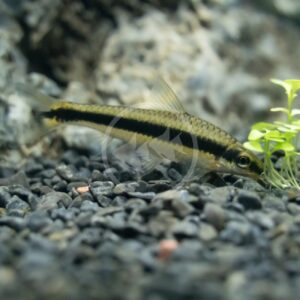
ALGAE EATER – SIAMESE / SAE
Crossocheilus oblongus
$7.99 – $24.99Price range: $7.99 through $24.99

PLECOSTOMUS – BRISTLENOSE ALBINO / GOLD
Ancistrus sp.
$5.99 – $59.99Price range: $5.99 through $59.99

CATFISH – OTOCINCLUS
Otocinclus vittatus
$7.99
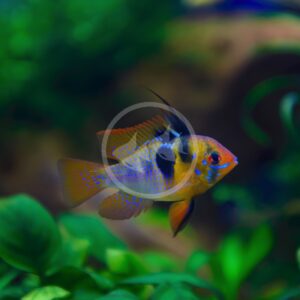
CICHLID – RAM GERMAN BLUE
Mikrogeophagus ramirezi
$12.99 – $24.99Price range: $12.99 through $24.99

MINNOW – WHITE CLOUD MOUNTAIN GOLD
Tanichthys albonubes
$5.99
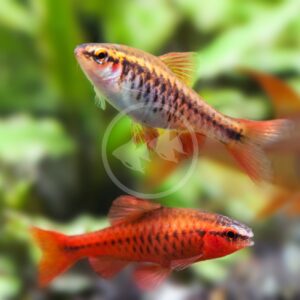
BARB – CHERRY
Puntius titteya
$3.99 – $9.99Price range: $3.99 through $9.99

GOURAMI – DWARF POWDER BLUE
Trichogaster lalius
$11.99 – $14.99Price range: $11.99 through $14.99
